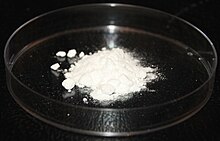| |||

| |||
| Names | |||
|---|---|---|---|
| Preferred IUPAC name
2-Benzofuran-1,3-dione[1] | |||
| Other names | |||
| Identifiers | |||
3D model (JSmol)
|
|||
| 118515 | |||
| ChEBI | |||
| ChEMBL | |||
| ChemSpider | |||
| ECHA InfoCard | 100.001.461 | ||
| EC Number |
| ||
| 27200 | |||
PubChem CID
|
|||
| RTECS number |
| ||
| UNII | |||
| UN number | 2214 | ||
CompTox Dashboard (EPA)
|
|||
| |||
| |||
| Properties | |||
| C8H4O3 | |||
| Molar mass | 148.1 g/mol | ||
| Appearance | white flakes | ||
| Odor | characteristic, acrid[2] | ||
| Density | 1.53 g/cm3, solid; 1.20 g/mL, molten[2] | ||
| Melting point | 131.6 °C (268.9 °F; 404.8 K) | ||
| Boiling point | 295 °C (563 °F; 568 K) sublimates | ||
| 0.62 g/100g (20—25 °C); 19.0 g/100g (100 °C); reacts slowly | |||
| Vapor pressure | 0.0015 mmHg (20 °C)[2] | ||
| −67.31×10−6 cm3/mol | |||
| Hazards | |||
| GHS labelling: | |||
  
| |||
| Danger | |||
| H302, H315, H317, H318, H334, H335 | |||
| P261, P264, P270, P271, P272, P280, P285, P301+P312, P302+P352, P304+P340, P304+P341, P305+P351+P338, P310, P312, P321, P330, P332+P313, P333+P313, P342+P311, P362, P363, P403+P233, P405, P501 | |||
| NFPA 704 (fire diamond) | |||
| Flash point | 152 °C (306 °F; 425 K) | ||
| Explosive limits | 1.7%–10.5% | ||
| Lethal dose or concentration (LD, LC): | |||
LD50 (median dose)
|
4020 mg/kg (oral, rat) 1520 mg/kg (oral, mouse) 800 mg/kg (oral, cat) 800–1600 mg/kg (oral, rat) 2210 mg/kg (oral, mouse)[3] | ||
| NIOSH (US health exposure limits): | |||
PEL (Permissible)
|
TWA 12 mg/m3 (2 ppm)[2] | ||
REL (Recommended)
|
TWA 6 mg/m3 (1 ppm)[2] | ||
IDLH (Immediate danger)
|
60 mg/m3[2] | ||
| Related compounds | |||
Related compounds
|
Phthalic acid Phthalimide Phthalide | ||
Except where otherwise noted, data are given for materials in their standard state (at 25 °C [77 °F], 100 kPa).
| |||
Phthalic anhydride is the organic compound with the formula C6H4(CO)2O. It is the anhydride of phthalic acid. Phthalic anhydride is a principal commercial form of phthalic acid. It was the first anhydride of a dicarboxylic acid to be used commercially. This white solid is an important industrial chemical, especially for the large-scale production of plasticizers for plastics. In 2000, the worldwide production volume was estimated to be about 3 million tonnes per year.[4]
- ^ a b c "Front Matter". Nomenclature of Organic Chemistry : IUPAC Recommendations and Preferred Names 2013 (Blue Book). Cambridge: The Royal Society of Chemistry. 2014. p. 835. doi:10.1039/9781849733069-FP001. ISBN 978-0-85404-182-4.
- ^ a b c d e f NIOSH Pocket Guide to Chemical Hazards. "#0512". National Institute for Occupational Safety and Health (NIOSH).
- ^ "Phthalic anhydride". Immediately Dangerous to Life or Health Concentrations (IDLH). National Institute for Occupational Safety and Health (NIOSH).
- ^ Cite error: The named reference
Ullmannwas invoked but never defined (see the help page).


